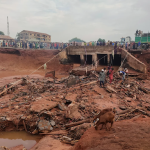
No fewer than 115 persons have been reported killed after a devastating flood submerged several communities in Mokwa in Niger State, North-central Nigeria.
Communities are still struggling from the impact of the severe flooding, which is believed to have been triggered by torrential rainfall and structural failures in some areas. The disaster, which struck the region on the morning of Thursday, May 29, has claimed over 100 lives so far. Residents of the area told HumAngle that the death toll is nearing 150 even as officials work to rescue more victims.
The spokesperson of Niger State Emergency Management Agency (NSEMA), Ibrahim Audu Hussein, told newsmen that over 3000 houses were submerged. Eyewitnesses report entire neighbourhoods submerged, forcing people to abandon their homes in search of safety.
“There are entire families that have been almost wiped out,” Farouk Mokwa, a resident of the community, told HumAngle. “There is a family of 12, and only one person is alive. There is another family of nine, and only two people have survived so far.”
Farouk himself lost his shop, which functioned as both a chemist and a stop for people looking to buy soft drinks. The shop contained three refrigerators and goods worth millions of naira, he said.
Rescue teams and emergency responders are on the ground to locate missing persons and provide relief to affected residents. The flooding has also cut off major roads, complicating rescue efforts and making access to food and medical supplies difficult.
So far, displaced people have sought refuge in two primary schools in Mokwa, while those with relatives in unaffected communities have trooped there in search of cover.
Mokwa serves as a commercial hub in Nigeria’s north-central region and a key point for traders and farmers from the north to the south.
In response, President Bola Tinubu has ordered swift intervention from the National Emergency Management Agency (NEMA) to support rescue operations. Residents also said the Deputy Governor had paid a visit to the area to assess the devastation.
Meanwhile, the Nigerian Meteorological Agency (NiMet) had issued prior warnings of potential flash floods, urging residents to take precautions.
Nigeria faces annual devastation due to heavy rainfall, which wreaks havoc on infrastructure and is made worse by inadequate drainage systems. In September 2024, HumAngle reported how torrential rains and a dam failure in Maiduguri, northeastern Nigeria, led to severe flooding, claiming lives and displacing millions of residents.
Two months after the Maiduguri incident, the United Nations Office for the Coordination of Humanitarian Affairs (OCHA) revealed that in 2024, Nigeria saw one of its worst floods in decades, with significant deaths leaving 1.3 million people affected across 34 out of 36 states.
Currently, the number of residents displaced by floods in Nigeria has reached 1.2 million, with over 1000 deaths, according to NEMA.
The worsening flood crises highlight the urgent need for improved drainage infrastructure and long-term disaster management strategies to protect vulnerable communities. As relief efforts continue, affected families are in dire need of temporary shelter, clean water, and essential supplies.
A catastrophic flood in Mokwa, North-central Nigeria, has resulted in over 115 fatalities and thousands displaced. Torrential rains and structural weaknesses caused the disaster, which has devastated communities since May 29. The flood submerged approximately 3,000 homes, leaving residents without shelter and complicating rescue efforts due to inaccessible major roads.
Amidst the crisis, President Bola Tinubu has instructed the National Emergency Management Agency (NEMA) to intervene, while local officials assess the damages. Prior warnings from the Nigerian Meteorological Agency about potential floods went unheeded. The ongoing disaster emphasizes the urgent need for effective drainage infrastructure and long-term disaster management plans to mitigate the effects of recurrent floods in Nigeria.
